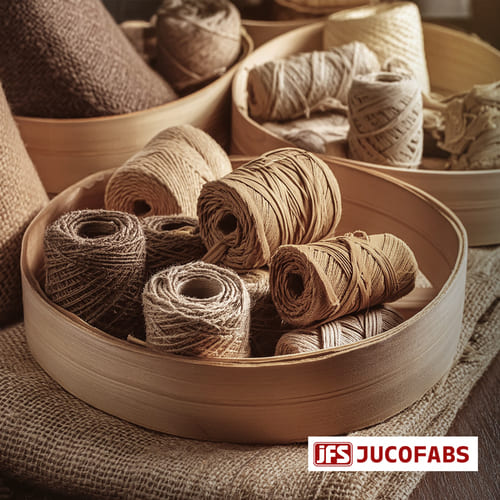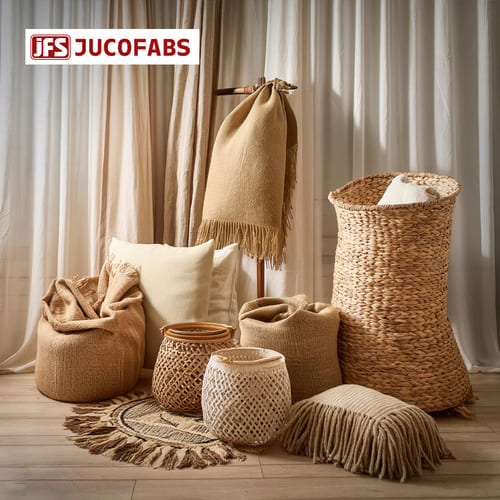Introduction
Jute has been a part of the textile world for centuries. known for its durability and versatility, this natural fibre has been used in many historical garments and items. In ancient times, jute was valued for its strength, so it was perfect for everything from clothing to household goods. Early civilisations used jute to make everything from sturdy sacks to elaborate tapestries. Today, jute is back in fashion as people rediscover its eco-friendly properties. In this blog, we’ll look at how jute was used in historical textiles and why it's back in vogue. Join us on a journey through time to see how this humble fibre shaped the fabric of the past.
› Tracing the Roots: The Origins of Jute Fabric
Jute fabric has its roots in the Bengal region of India and Bangladesh. It has been cultivated for over 5,000 years. This fibre was used in traditional textiles, ropes, and household items. Its versatility made it popular in ancient times. People liked jute for its strength and affordability. Historical records show it was traded widely and was a part of local economies. Jute’s legacy in textile history remains!
Jute's Role in Ancient Cultures
Jute has a rich history dating back to ancient times. Here’s how jute made its mark:
› Usage in the Mughal Empire for ropes and packaging
The Mughal Empire used jute to make strong ropes and durable packaging materials. Jute’s strength and availability made it a part of trade and daily life.
› Adoption by the Chinese for making paper
The Chinese were the first to use jute for papermaking. Jute fibres were processed into pulp and used to make high-quality paper. This shows the jute’s versatility and importance in ancient times.
Jute's historical uses highlight its longstanding value and durability.
Jute's Role in Colonial Trade and Industry
In colonial times,
jute played a big part in textile history. The British East India Company popularised jute by recognising its use for ropes, sacks, and other products. Dundee, in Scotland, became famous for its jute mills, which processed jute imported from India. These mills produced jute products and boosted local economies.
› The role of the British East India Company in popularising jute
- The British East India Company introduced jute to the world.
- They saw its potential and started exporting it from Bengal to Britain.
› Establishment of jute mills in Bengal and Dundee
- The first jute mill in Bengal was set up in 1855, and the jute industry grew.
- In Dundee, Scotland, jute mills became the hub of jute processing, and it became an industrial town.
- These mills boosted the jute trade and created economic ties between India and Britain.
How did jute shape industrial advancements in the 19th century?
In the Industrial Era, jute became super important, especially in the textile industry. Here’s how:
› Expansion of jute mills and exportation to Europe and America
- Jute mills grew extremely fast in the industrial era.
- Europe and America became the biggest markets for jute products.
- Exporting jute boosts the economies of the regions producing it.
› Jute's importance during the American Civil War and World Wars
- Jute was used to make sandbags and sacks during the American Civil War.
- During both World Wars, jute was used for military supplies.
- Its durability made it a preferred material for all wartime needs.
Jute's versatility and abundance made it a staple in industrial and wartime applications.
Jute’s Role in Traditional Crafts and Cultural Heritage
Traditional Crafts
Cultural Heritage
› Use of jute in traditional Indian attire and crafts
- Traditional Attire: Jute has been used in traditional Indian attire in places like West Bengal and Assam. Sarees and kurtas use jute fabric for their durability and texture.
- Handicrafts: Artists make beautiful crafts like bags, mats, and wall hangings using jute. These are a reflection of India’s rich cultural heritage and craftsmanship.
- Festivals: During festivals, jute is used to make decorations and accessories, adding a rustic touch to the celebrations.
› Jute in military applications: Ghillie suits and other gear
- Ghillie Suits: Jute is a key material in making Ghillie suits for military snipers. Its natural fibres blend in with the environment, providing great camouflage.
- Protective Gear: Jute is used in various military gear because of its strength and affordability. It is used in making ropes, sandbags, and other essential equipment.
- Environmental Benefits: Using jute in military applications also helps with sustainability, reducing dependence on synthetic materials.
Welcome to JUCOFABS, a leading manufacturer and exporter of Jute and Cotton Products. The state of art facility manufactures a wide range of Jute rolls,
Jute at Home: Practical and Eco-Friendly Domestic Uses
Jute has been used in homes for ages. Here’s how:
› Development of household items: sacks, rugs, and curtains
- Sacks: Jute sacks have been used to carry grains, spices, and other goods for ages due to their durability.
- Rugs: Jute rugs add a natural, rustic touch to interiors. Eco-friendly and suitable for all home styles.
- Curtains: Jute curtains bring a unique texture to windows, a natural look, and a bit of privacy.
› Innovations in jute weaving techniques and patterns
- Patterns: Modern weavers have introduced new designs to make jute products look more beautiful.
- Techniques: New weaving methods make jute products stronger and more useful for household use.
Jute continues to be a versatile and sustainable choice for home furnishings.
Jute Today: Eco-Friendly Innovations and Sustainable Practices
Jute isn’t just old-fashioned; it’s making waves today. Here’s how:
› Contemporary applications of jute in eco-friendly products
- Used in reusable shopping bags.
- Found in biodegradable packaging materials.
- Eco-friendly home decor items like rugs and cushions.
› Jute's role in promoting sustainable practices and reducing the carbon footprint
- Jute is a natural fibre, so it’s biodegradable.
- Growing jute absorbs CO2, reducing greenhouse gases.
- It requires fewer pesticides and fertilisers, so it’s eco-friendly.
Jute is the key to our green future, combining old and new.
Jute's Timeless Legacy and Future
Jute has been a big part of historical textiles. Its durability and versatility made it a go-to for everything from clothing to home goods. The natural strength of jute could withstand wear and tear, so it was perfect for everyday items. Today, we can see how the jute’s history has influenced its modern uses. As we look for sustainable solutions, jute’s legacy reminds us of its value in eco-friendly solutions. By embracing jute’s heritage, we honour its past and present and celebrate its part in sustainable living.

